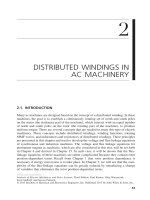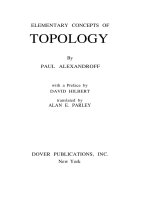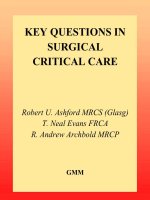key concepts in turbo machinery
Bạn đang xem bản rút gọn của tài liệu. Xem và tải ngay bản đầy đủ của tài liệu tại đây (4.6 MB, 144 trang )
1
WWW.BOOKBOON.COM
FREE STUDY BOOKS
FREE STUDY BOOKS
BASIC CONCEPTS IN
TURBOMACHINERY
GRANT INGRAM
Download free books at BookBoon.com
2
Grant Ingram
Basic Concepts in Turbomachinery
Download free books at BookBoon.com
3
Basic Concepts in Turbomachinery
© 2009 Grant Ingram & Ventus Publishing ApS
ISBN 978-87-7681-435-9
Download free books at BookBoon.com
Basic Concepts in Turbomachinery
4
Contents
1 Introduction
1.1 How this book will help you
1.2 Things you should already know
1.3 What is a Turbomachine?
1.4 A Simple Turbine
1.5 The Cascade View
1.6 The Meridional View
1.7 Assumptions used in the book
1.8 Problems
2 Relative and Absolute Motion
2.1 1D Motion
2.2 2D Motion
2.3 Velocity Triangles in Turbomachinery
2.4 Velocity Components
2.5 Problems
3 Simple Analysis of Wind Turbines
3.1 Aerofoil Operation and Testing
3.2 Wind Turbine Design
3.3 Turbine Power Control
Contents
16
17
17
17
18
19
23
23
24
25
26
27
28
30
33
35
38
41
44
Please click the advert
Download free books at BookBoon.com
Basic Concepts in Turbomachinery
5
3.4 Further Reading
3.5 Problems
4 Different Turbomachines and Their Operation
4.1 Axial Flow Machines
4.2 Radial and Centrifugal Flow Machines
4.3 Radial Impellers
4.4 Centrifugal Impellers
4.5 Hydraulic Turbines
4.6 Common Design Choices
4.7 The Turbomachine and System
4.8 Problems
5 Application of The Equations of Fluid Motion
5.1 Conservation of Mass
5.1.1 Application to Radial Machines
5.2 Conservation of Momentum
5.2.1 The Difference Between a Single Aerofoil and a Cascade of Blades
5.3 Conservation of Energy and Rothalpy
5.3.1 Rothalpy
5.3.2 Rothalpy in Stators and Rotors
5.4 Problems
6 Effi ciency and Reaction
6.1 Effi ciency
Contents
44
45
46
47
47
49
52
54
57
59
60
61
61
63
64
68
69
71
71
73
74
74
WHAT‘S MISSING IN THIS EQUATION?
MAERSK INTERNATIONAL TECHNOLOGY & SCIENCE PROGRAMME
You could be one of our future talents
Are you about to graduate as an engineer or geoscientist? Or have you already graduated?
If so, there may be an exciting future for you with A.P. Moller - Maersk.
www.maersk.com/mitas
Please click the advert
Download free books at BookBoon.com
Basic Concepts in Turbomachinery
Contents
6
6.1.1 Using Effi ciency
6.1.2 Other Effi ciency Defi nitions
6.2 Reaction
6.3 Reaction on the h − s Diagram
6.4 Problems
7 Dimensionless Parameters for Turbomachinery
7.1 Coeffi cients for Axial Machines
7.2 Coeffi cients for Wind Turbines
7.3 Coeffi cients for Hydraulic Machines
7.3.1 Specifi c Speed for Turbines
7.3.2 Specifi c Speed for Pumps
7.3.3 Using Specifi c Speeds
7.4 Problems
8 Axial Flow Machines
8.1 Reaction for Repeating Stage
8.1.1 Zero Reaction (Impulse) Stage
8.1.2 50% Reaction Stage
8.2 Loading and Effi ciency Variation with Reaction
8.3 Stage Effi ciency
8.4 Choice of Reaction for Turbines
8.5 Compressor Design
8.6 Multistage Steam Turbine Example
8.7 Problems
77
78
78
79
82
83
84
87
88
90
91
91
93
94
94
97
97
98
100
101
102
103
106
www.job.oticon.dk
Download free books at BookBoon.com
Basic Concepts in Turbomachinery
Contents
7
9 Hydraulic Turbines
9.1 Pelton Wheel
9.2 Analysis Approach
9.3 Francis Turbine
9.4 Kaplan Turbine
9.4.1 Loss Estimation
9.4.2 Draft Tube Analysis
9.4.3 Effect of Draft Tube
9.5 Problems
10 Analysis of Pumps
10.0.1 Pump Geometry and Performance
10.1 Pump Diffuser Analysis
10.2 Pump Losses
10.3 Centrifugal Pump Example
10.4 Net Positive Suction Head (NPSH)
10.4.1 Cavitation Example
10.5 Application to Real Pumps
10.6 Problems
11 Summary
Appendix A: Glossary of Turbomachinery Terms
Appendix B: Picture Credits
108
109
110
110
116
120
121
123
124
126
127
129
130
132
135
137
138
138
139
141
144
Always aiming for higher ground.
Just another day at the office for a Tiger.
©
2009 Accenture. All rights reserved.
Visit student.accentureforum.dk
Join the Accenture High Performance Business Forum
On Thursday, April 23rd, Accenture invites top students
to the High Performance Business Forum where you
can learn how leading Danish companies are using
the current economic downturn to gain competitive
advantages. You will meet two of Accenture’s global
senior executives as they present new original research
and illustrate how technology can help forward
thinking companies cope with the downturn.
Visit student.accentureforum.dk to see the program
and register
Please click the advert
Download free books at BookBoon.com
Basic Concepts in Turbomachinery
8
List of Figures
1.1 Applications of Turbomachinery
1.2 A Simple Turbine
1.3 A Simple Turbine: Exploded View
1.4 Simple Turbine Operation
1.5 Cascade View
1.6 The Cascade View as a Large Radius Machine
1.7 Meridional View
2.1 Relative and Absolute Velocities for a Cyclist
2.2 Velocity Triangles for an Aircraft Landing
2.3 Graphical Addition and Subtraction of Vectors
2.4 Cascade and Meridional Views of a Turbine Stage
2.5 Velocity Triangles for a Turbine Stage
2.6 Velocity Triangles at Station 3 of a Turbine
2.7 Velocity Triangles for a Desk Fan
3.1 Wind Turbine Picture and Sketch
3.2 Wind Turbine Blade and Velocity Triangle
3.3 Forces on a Wind Turbine Blade
3.4 Aerofoil at Two Incidences
3.5 C
L
and C
D
for a NACA 0012 Aerofoil
3.6 Relationship between and i
3.7 Schematic Showing Wind Turbine Pitch Control
List of Figures
18
20
20
21
21
22
24
26
27
28
29
31
32
33
36
37
37
39
41
42
45
it’s an interesting world
Get under the skin of it.
Graduate opportunities
Cheltenham | £24,945 + benefits
One of the UK’s intelligence services, GCHQ’s role is two-fold:
to gather and analyse intelligence which helps shape Britain’s
response to global events, and, to provide technical advice for the
protection of Government communication and information systems.
In doing so, our specialists – in IT, internet, engineering, languages,
information assurance, mathematics and intelligence – get well
beneath the surface of global affairs. If you thought the world was
an interesting place, you really ought to explore our world of work.
www.careersinbritishintelligence.co.uk
Applicants must be British citizens. GCHQ values diversity and welcomes applicants from
all sections of the community. We want our workforce to reflect the diversity of our work.
TOP
GOVERNMENT
EMPLOYER
Please click the advert
Download free books at BookBoon.com
Basic Concepts in Turbomachinery
9
4.1 Radial Pump
4.2 3D View of the Radial Impeller
4.3 Centrifugal Impeller
4.4 The Cascade View for a Radial Impeller
4.5 Velocity Triangles for a Radial Impeller
4.6 Common errors in Velocity Triangles
4.7 Constructing the Cascade View for a Centrifugal Impeller
4.8 Velocity Triangles for a Centrifugal Impeller
4.9 Schematic of Hydro-Electric Scheme
4.10 The Four Major Types of Hydraulic Turbine
4.11 Pelton’s Patent Application and Analysis Model
4.12 Three Dimensional Views of a Francis Turbine
4.13 Three Dimensional Views of a Kaplan Turbine
5.1 Meridional View of a Gas Turbine
5.2 Meridional Views of Radial and Centrifugal Machines
5.3 A Generic Turbomachinery Flow Passage
5.4 Isolated Aerofoil compared to a Cascade
5.5 Generic Velocity Triangle
6.1 Enthalpy-Entropy Diagram for a Turbine
6.2 Enthalpy-Entropy Diagram for a Compressor
6.3 Basic h-s diagram
6.4 h-s diagram with h
0
6.5 h-s diagram with h
0
and h
0rel
List of Figures
48
48
49
50
50
52
53
54
55
56
58
58
59
64
65
67
68
72
75
76
81
81
82
By 2020, wind could provide one-tenth of our planet’s
electricity needs. Already today, SKF’s innovative know-
how is crucial to running a large proportion of the
world’s wind turbines.
Up to 25 % of the generating costs relate to mainte-
nance. These can be reduced dramatically thanks to our
systems for on-line condition monitoring and automatic
lubrication. We help make it more economical to create
cleaner, cheaper energy out of thin air.
By sharing our experience, expertise, and creativity,
industries can boost performance beyond expectations.
Therefore we need the best employees who can
meet this challenge!
The Power of Knowledge Engineering
Brain power
Plug into The Power of Knowledge Engineering.
Visit us at www.skf.com/knowledge
Please click the advert
Download free books at BookBoon.com
Basic Concepts in Turbomachinery
10
7.1 Velocity triangles for exit and inlet combined
7.2 C
P
vs for 2.5MW Wind Turbine
7.3 Collapsing Pump Data onto Non-dimensional Curves
7.4 Specifi c Speed for a Number of Hydraulic Turbines
8.1 h-s diagram with h
0
and h
0rel
8.2 Impulse and 50% Reaction Blading
8.3 Locations for Tip Clearance Flow
8.4 Schematics of Disc and Diaphragm Construction
9.1 Pelton’s Patent Application and Analysis Model
9.2 Analysis of a Francis Turbine
9.3 Velocity Triangle for Francis Turbine Guide Vane Exit
9.4 Velocity Triangle for Francis Runner Exit
9.5 Analysis of a Kaplan Turbine
9.6 Velocity Triangle for a Kaplan Turbine at Guide Vane Exit
9.7 Velocity Triangle for a Kaplan Runner
10.1 Three Blade Angles at Impeller Exit
10.2 H vs Q for Three Blade Angles
10.3 P vs Q for Three Blade Angles
10.4 Inlet to Pump Impeller
10.5 Exit from Pump Impeller
10.6 Pump Inlet
List of Figures
85
89
89
93
95
98
101
102
109
111
113
115
117
118
119
128
128
129
132
133
135
NNE and Pharmaplan have joined forces to create
NNE Pharmaplan, the world’s leading engineering
and consultancy company focused entirely on the
pharma and biotech industries.
Inés Aréizaga Esteva (Spain), 25 years old
Education: Chemical Engineer
NNE Pharmaplan is the world’s leading engineering and consultancy company
focused entirely on the pharma and biotech industries. We employ more than
1500 people worldwide and offer global reach and local knowledge along with
our all-encompassing list of services. nnepharmaplan.com
– You have to be proactive and open-minded as a
newcomer and make it clear to your colleagues what
you are able to cope. The pharmaceutical fi eld is new
to me. But busy as they are, most of my colleagues
fi nd the time to teach me, and they also trust me.
Even though it was a bit hard at fi rst, I can feel over
time that I am beginning to be taken seriously and
that my contribution is appreciated.
Trust and responsibility
Please click the advert
Download free books at BookBoon.com
Basic Concepts in Turbomachinery
11
Nomenclature
A Area
b Blade height
c Chord length
C
D
Dissipation coefficient or drag coefficient
C
L
Lift coefficient
C
p
Specific heat capacity at constant pressure or power coefficient for wind turbines
C
v
Specific heat capacity at constant volume
D Machine diameter
g Acceleration due to gravity
Nomencalture
Please click the advert
Download free books at BookBoon.com
Basic Concepts in Turbomachinery
12
h Enthalpy or static pressure head
H Total head
i Incidence angle
I Rothalpy
k Loss coefficient
K Dimensionless specific speed or loss coefficient
L Angular momentum
˙m Mass flow rate
N Rotation speed in revolutions per second or Dimensional specific speed
p Pressure
P Power
Q Flow rate
q Heat transfer
R Gas constant or Reaction or tip radius
r Radial coordinate
r
m
Mean radius
r
t
Tip radius
r
h
Hub radius
s Blade pitch or entropy
t Time or blockage factor
T Torques or temperature
U Frame velocity vector
U Frame velocity magnitude
V Absolute velocity vector
V Absolute velocity magnitude
W Relative velocity vector
w Work
W Relative velocity magnitude
x Axial coordinate
z Height
α Absolute flow angle
Nomencalture
Download free books at BookBoon.com
Basic Concepts in Turbomachinery
13
β Relative flow angle
γ Ratio C
p
/C
v
or blade inlet angle for wind turbines
Θ Angle made by Pelton wheel bucket
θ Tangential coordinate
λ Tip speed ratio for wind turbines
Π Dimensionless parameter
η Efficiency
ρ Density
μ Viscosity
σ Thoma’s parameter for cavitation
Φ Stage loading coefficient
ψ Flow coefficient
ω Rotational speed
Nomencalture
Please click the advert
Download free books at BookBoon.com
Basic Concepts in Turbomachinery
14
Acknowledgements
This book is based on an introductory turbomachinery course at Durham University. This course
was taught by Dr David Gregory-Smith and Professor Li He over a number of years and I am ex-
tremely grateful to them for providing a clear and lucid set of principles on which to base this work.
My current colleagues at Durham Dr Rob Dominy and Dr David Sims-Williams have also provided
invaluable help (even if they didn’t realise it!) in preparing this work.
The book is designed to help students over some important “Threshold Concepts” in educational
jargon. A threshold concept is an idea that is hard to grasp but once the idea is understood transforms
the student understanding and is very hard to go back across. Within turbomachinery my view is
that understanding the cascade view, velocity triangles and reaction form three threshold concepts,
perhaps minor ones compared to the much bigger ideas such as “reactive power” or “opportunity
cost” that are also proposed but this view has significantly influenced the production of this book.
I’d therefore like to acknowledge Professor Eric Meyer for introducing me to the idea of threshold
concepts.
Acknowledgements
Download free books at BookBoon.com
Basic Concepts in Turbomachinery
15
About the Author
Grant Ingram has been a Lecturer in Fluid Mechanics at Thermodynam-
ics at the University of Durham since 2005. He spent time working in the
power generation industry on everything from large steam turbines, large
and small gas turbines, pumps and hydro-electric turbines before return-
ing to academic life to complete a PhD on turbine aerodynamics spon-
sored by Rolls-Royce. At the University Grant Ingram conducts research
on making Turbomachinery more efficient with a particular emphasis on
three dimensional design techniques for high performance turbomachin-
ery. He also works on renewable devices work and has conducted a num-
ber of studies on small wind turbines both computationally and using
experimental testing. He lectures on Thermodynamics, Turbomachinery
and Fluid Mechanics at undergraduate and MSc level as well as directing
short courses for industry in Thermodynamics and Turbomachinery.
About the Author
Download free books at BookBoon.com
Basic Concepts in Turbomachinery
16
Chapter 1
Introduction
This book is designed to help you understand turbomachinery. It aims to help you over some of the
difficult initial concepts so that your work or study with turbomachinery will be much more fruitful.
It does not tell you how to design a turbomachine but instead aims to make your other studies, lectures
and textbooks which go into more depth make much more sense. For those readers not concerned with
turbomachinery design it might provide all the background they need. It is based on an introductory
course taught at Durham University for some years.
There are actually only three really difficult ideas in this book: understanding the cascade view
(Chapter
1), velocity triangles (Chapter 2)and the concept of reaction (Chapter 6). Once you have
mastered those three concepts Turbomachinery actually becomes relatively straightforward!
Introduction
Please click the advert
Download free books at BookBoon.com
Basic Concepts in Turbomachinery
17
This book is available on-line and any comments or suggestions about the book are gratefully
received by the author. He can be contacted via e-mail at:
1.1 How this book will help you
The book is designed to provide guidance on the basics. So if someone is presenting a velocity
triangle which you do not understand or you have absolutely no idea what a stator is this book will
help. Armed with this understanding you can then go on use the more complex texts effectively.
The book also contains examples which illustrate how understanding these basic concepts lead to
an immediate appreciation of why machines look the way they do. So for example you will rapidly be
able to see why wind turbine blades are twisted, why a the blade height in a steam turbine increases
towards the low pressure end and why pump blades often point away from the direction of rotation.
The most valuable learning experience however is to actually manipulate the ideas contained in
this text. A series of problems are provided at the end of each chapter with numerical answers - to
fully understand the material in this book you should attempt these problems.
1.2 Things you should already know
This book is directed at readers with a basic knowledge of Fluid Mechanics and Thermodynamics.
In order to make best use of the book you should have some knowledge of the steady flow energy
equation, static and stagnation conditions, the perfect gas law, how to use steam tables and charts and
an understanding of the boundary layer.
1.3 What is a Turbomachine?
A turbomachine is a device that exchanges energy with a fluid using continuously flowing fluid and
rotating blades. Examples of these devices include aircraft engines and wind turbines.
If the device extracts energy from the fluid it is generally called a turbine. If the device delivers
energy to the fluid it is called a compressor, fan, blower or pump depending on the fluid used and the
magnitude of the change in pressure that results. Turbomachinery is the generic name for all these
machines.
Somewhat confusingly the word turbine is sometimes applied to a complete engine system on an
aircraft or in a power station, e.g. “a Boeing 747 is equipped with four gas turbines for thrust”. A
glossary is in Appendix
A on page 137 at the end of the book to help you navigate your way through
the turbomachinery jargon.
Turbomachinery is essential to the operation of the modern world. Turbines are used in all sig-
nificant electricity production throughout the world in steam turbine power plants, gas turbine power
plants, hydro-electric power plant and wind turbines. Pumps are used to transport water around mu-
nicipal water systems and in homes, pumps and turbines are also essential in the transportation of
fuel oil and gas around pipe networks. Gas turbine engines are used to power all large passenger
Introduction
Download free books at BookBoon.com
Basic Concepts in Turbomachinery
18
Figure 1.1: Applications of Turbomachinery
aircraft either in the form of turbo-prop or turbo-fan engines and also through a gearbox they power
all helicopter engines.
In short turbomachinery is all around you and is an area worthy of further study! Figure 1.1 shows
four important applications of turbomachinery, in the top left gas turbine propulsion for aeroplanes,
in the top right wind turbine power of electricity production, in the bottom left the rotor of a steam
turbine for power production and a water pump is shown in the bottom right.
1.4 A Simple Turbine
There are many variants of turbine, here we describe the operation of a simple turbine so you get a
feel for what is going on. An outline of a turbine is shown in Figure
1.2. From this view all we know
about the device is that flow goes into it and as if by magic the shaft turns and produces a torque.
If we look at the device in an exploded view (Figure
1.3) we see that as well as a number of covers
and bearings there is a row of aerodynamically shaped objects that don’t move followed by a row of
aerodynamically shaped objects that provide the torque to the shaft.
The objects are known various as blades, buckets, nozzles, aerofoils or airfoils. In this book we
will generally refer to them as blades. The row of stationary blades is known as a stator and the row
of rotating blades connected to the output shaft is known as the rotor.
The basic mechanism of operation is as follows (Figure
1.4):
1. the fluid flows directly into the device in an axial direction (in line with the machine)
2. the stator blades turn the flow so that it is lined up with the turbine blades
3. the turbine blades turn the flow back towards the axial direction and turn the output shaft.
Introduction
Download free books at BookBoon.com
Basic Concepts in Turbomachinery
19
The key point is that the power extraction from the fluid arises from turning the flow. More
complex turbines use more than one row of rotors and stators, but all work on the same essential
principle. A question often asked at this point is that since all the power comes from the rotor can you
do without a stator? The answer is yes! Wind turbines extract power from fluid with the need for a
stator. However for flows with much larger energy densities such as those in aircraft engines adding
a stator allows you to get much more energy out of the subsequent stator row - the reason for this is
found in Chapter
5.
1.5 The Cascade View
There are two key views of turbomachinery used throughout this book (and in turbomachinery design
in general). These are the cascade view and the meridional view.
The cascade view arises from looking at the stator and rotor of the simple turbine shown earlier
(Top half of Figure
1.5) if you look closely at the topmost part of the turbine you can see the blades
of the stator and rotor outlined in plan view. This is highlighted by a red box. You can actually do
this for any rotor/stator blade combination around the circumference of the turbine. The fact that
you can do this for every blade suggests that the plan view may be an excellent way of analysing the
performance of the machine.
The 2D cascade view of the simple turbine is shown in the lower half of Figure
1.5. The cascade
view with a single stator and rotor blade is highlighted with a red box. The relation between the 2D
cascade view and the 3D real turbine should be obvious. The rest of the cascade view is made up of
plan views of the other stator and rotor blade combinations. When looking directly down onto the red
box in the the 3D view of the turbine the movement of the rotor blade appears to be simply from left
Introduction
Dedicated Analytical Solutions
FOSS
Slangerupgade 69
3400 Hillerød
Tel. +45 70103370
www.foss.dk
The Family owned FOSS group is
the world leader as supplier of
dedicated, high-tech analytical
solutions which measure and
control the quality and produc-
tion of agricultural, food, phar-
maceutical and chemical produ-
cts. Main activities are initiated
from Denmark, Sweden and USA
with headquarters domiciled in
Hillerød, DK. The products are
marketed globally by 23 sales
companies and an extensive net
of distributors. In line with
the corevalue to be ‘First’, the
company intends to expand
its market position.
Employees at FOSS Analytical A/S are living proof of the company value - First - using
new inventions to make dedicated solutions for our customers. With sharp minds and
cross functional teamwork, we constantly strive to develop new unique products -
Would you like to join our team?
FOSS works diligently with innovation and development as basis for its growth. It is
reflected in the fact that more than 200 of the 1200 employees in FOSS work with Re-
search & Development in Scandinavia and USA. Engineers at FOSS work in production,
development and marketing, within a wide range of different fields, i.e. Chemistry,
Electronics, Mechanics, Software, Optics, Microbiology, Chemometrics.
Sharp Minds - Bright Ideas!
We offer
Please click the advert
Download free books at BookBoon.com
Basic Concepts in Turbomachinery
20
Figure 1.2: A Simple Turbine
Figure 1.3: A Simple Turbine: Exploded View
Introduction
Download free books at BookBoon.com
Basic Concepts in Turbomachinery
21
Figure 1.4: Simple Turbine Operation
Figure 1.5: Cascade View
Introduction
Download free books at BookBoon.com
Basic Concepts in Turbomachinery
22
Figure 1.6: The Cascade View as a Large Radius Machine
to right. So in the cascade view the rotary motion in the 3D model becomes 2D linear motion in the
cascade view.
We can then analyse how the turbine blades influence the flow by looking at this 2D cascade view,
since the cascade view is the same for every blade passage around the circumference of the turbine.
Although we have completed this for the top of the turbine we can repeat the exercise at any radius
from the hub of the machine to the tip.
An alternative way of looking at the cascade view is to say that we are examining an infinite
radius machine. Consider Figure
1.6 which contains three views, the first is a 3D view of a simple
turbine, the second shows a sketch of the turbine as viewed from upstream with the blades and hub
shown in schematic form. To form the cascade view we can approximate the real turbine rotating at
speed ω with a tip radius R =0.15m and a spacing between the blades of s with a machine with an
infinite radius and the same blade spacing (or pitch) of s. The rotation of the machine ω is replaced
by a linear motion of magnitude ωR where R is the radius of the original machine.
The actual cascade view involves looking down from the casing to the hub so you get a plan view
of the blades. Note that in the real machine the pitch s gets larger with larger radius r so the cascade
view only accurately represents the machine at a single radius. For machines with very large changes
of radius such as wind turbines we can draw a number of cascade views at different radii.
The cascade has two “analysis stations” associated with it at inlet and outlet. A consequence of
the cascade view is the properties of the fluid (pressure, temperature etc) going through the machine
are assumed constant in the tangential direction since there is no change in geometry or flow between
one blade and the next in that direction. In the real machine this assumption represents properties
being constant around the circumference of the machine so that a single value describes the fluid state
around the whole machine. Analysis stations can also be applied to parts of the turbomachine that
don’t always have rotational symmetry such as the inlet or the exit pipe - what is assumed there is
that a single value accurately represents the flow in the inlet or the exit.
Introduction
Download free books at BookBoon.com
Basic Concepts in Turbomachinery
23
1.6 The Meridional View
The meridional view is much more straightforward than the cascade view and is illustrated in Figure
1.7. On the left of Figure 1.7 is the familiar 3D view of our simple turbine. For the meridional view
instead of looking at the tip of the blade this time we take a side on view of the whole turbine and
look at a cross section of the machine at the hub and tip radius. This is highlighted by a red box. On
the right of Figure
1.7 is the actual meridional view which shows the stator followed by the rotor in
cross section. The actual machine radius r is usually very large compared to the blade height b and
so the axis of rotation is not always shown in the meridional view.
1.7 Assumptions used in the book
It is easy to see how the real turbomachinery flow field is three dimensional and unsteady now that
the complex geometry of machine has been shown. In addition the flow is compressible so density
changes have to be accounted for. However to introduce the basic concepts we can dispense with a
great deal of this complexity by making a number of assumptions about the flow field.
1. The flow is symmetric in the circumferential direction. There is no variation in the flow from
one side of the blades to another
2. We consider a mean flow (technically called a stream surface) between the hub and casing.
This is reasonable for short blades, for longer blades the “trick” is to repeat the calculation at a
number of radii.
Introduction
+LZPNU`V\Y
V^UM\[\YLH[
4(5+PLZLS
^^^THUKPLZLSJVT
Please click the advert
Download free books at BookBoon.com
Basic Concepts in Turbomachinery
24
Figure 1.7: Meridional View
3. Flow is steady. Although state of the art blade design requires a consideration of unsteady flow
most of the turbomachinery in use today has been designed with this steady flow assumption.
4. Flow follows the blade exactly. There is no deviation between the direction that the blades are
pointing and the direction that the fluid travels in. (In turbomachinery jargon: the flow follows
the metal angle of the blades)
These assumptions may seem quite limiting but most of them are used in the preliminary design
of all turbomachinery in use today so actually get you a surprisingly long way!
1.8 Problems
1. Explain why a bicycle pump is not classified as a turbomachine.
2. Sketch the cascade and meridional views for a horizontal axis wind turbine such as the one in
the top right of Figure
1.1.
Introduction
Download free books at BookBoon.com
Basic Concepts in Turbomachinery
25
Chapter 2
Relative and Absolute Motion
One of the key concepts in turbomachinery is understanding how the flow appears from the point of
view of components that are rotating compared to those that are stationary. Once this is understood
this the shape of turbomachinery becomes much easier to understand! Viewing flows from the point
of view of a rotating component is known as being in the relative frame of reference and viewing flows
from the point of view of a stationary observer is called being in the absolute frame of reference.
We start therefore with a simple explanation of relative and absolute motion before ending this
Chapter with a discussion of how this relates to turbomachines.
Relative and Absolute Motion
Please click the advert









